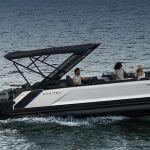While many Outdoor companies were able to capitalize on the growth of the military business the last few years, the adventure travel industry has felt the opposite effects since 9/11. Recently, this trend seems to be reversing itself, leaving many military-dependent companies looking for the next opportunity while many travel companies are experiencing a resurgence and are able to broaden their reach. This resurgence may be due in part to a U.S. consumer that has adjusted to the heightened security, causing concerns over travel safety to fall by the wayside. Many companies, both vendors and retailers, are seeing the effects and adjusting strategies, product offerings, and marketing efforts accordingly.
On paper, the resurgence appears to be gaining steam. The U.S. Bureau of Transportation Statistics has been reporting consistent increases in airline passenger traffic, with domestic passengers increasing 7% during the first quarter of 2005 and international in-bound air traffic up 6%. Outdoor Industry Association reported in their bi-annual Top-Line Retail Audit that sales of certain travel related hardgoods are on the rise. Over the twelve-month period from February 1, 2004 through January 31, 2005, suitcase and garment bag sales at specialty outdoor retailers have increased 26.8% while sales of duffels increased 10.1% during the same period. Apparel sales through outdoor retailers have been strong for several years straight.
The Adventure Travel Trade Association (see BOSS_0442), is bringing even more exposure to this corner of the outdoor industry. In a survey, the ATTA and Michigan State University found that 79% of 117 adventure travel businesses randomly surveyed are “optimistic” or “highly optimistic” about increases in passenger bookings for 2005, and most surveyed had already exceeded 2005 booking projections. An Eagle Creek March/April 2005 consumer survey revealed that one of its core customer demographics, the Baby Boomer, intends to travel more this year than in prior years.
Pam Stoesser, director of marketing at Kiva Designs, agrees with much of this research. “The Baby Boomer generation is on the move, and their whole attitude about travel is evolving from a passive tourist into a more active, hands-on traveler,” she said. “Travel with a purpose is also becoming more and more popular. I think because of the war in Iraq, people have developed a Peace Corps mentality and wherever they go, they want to interact with the culture.”
Many other vendors are finding similar trends in their market research. As the average American life-span gets longer, more people are viewing retirement as a time to accomplish life goals, rather than a time to become inactive. For many, these life goals include seeing the world. As more baby boomers retire, the Adventure Travel Industry will see further growth.
One of the main concerns that has dragged the travel industry down in recent years has been safety. Adam Ziegelman, Eagle Creeks director of marketing, told BOSS that travelers have become somewhat desensitized to the heightened security issues in the world today. “Psychology 101 teaches you that humans adapt to stresses in life,” he said. “We know all about the situation in Iraq. In the U.S. over the last couple of years, people have been cocooning and buying their plasma screens. Now, they are ready to get out.”
Magnus McGlashan, PacSafe partner and co-founder agrees with Ziegelmans sentiment. “I believe the rebound is driven in part by people putting their travel plans on hold over the last 2 years,” he said. “Now that the airline and airport security is at its highest levels people feel comfortable taking that long awaited overseas trip.”
It also appears that some retailers are embracing the resurgence, while others are hesitant to commit large amounts of square footage to the category. To an extent, there is a lingering fear that the travel market could still be unstable, especially if there is another terrorist attack or another outbreak of SARS, but these fears are disappearing as sales pick up.
“I think that some retailers are hesitant but I also think that this is changing quickly. Retailers know their customers better than anyone. If customers are coming into the store looking for travel products I believe that many react very quickly,” said PacSafes McGlashan. “We have noticed that retailers who kept committed to travel are now in a good position to take advantage of the rebound.”
Eagle Creeks Ziegelman feels that this fear is unfounded. “All of our research says that if there is another attack, there will be a dip in the numbers, but it will not be as severe or as prolonged as it was previously. This summer, travel spending should hit its highest point on record with $600 billion in U.S. travel expenditures.”
Ziegelman said that some retailers are realizing the opportunity and turning travel into the hub of their store. This is causing the consumer to look at adventure travel in a different light as a necessity that supports all other outdoor sports.
Eastern Mountain Sports CEO Will Manzer told BOSS that EMS will be marketing heavily to adventure travelers, but going after a different demographic. “We are taking a very aggressive position, but we dont call it adventure travel. We look at it more in terms of Geo-Tourism no itinerary, total cultural emersion, travel to an exotic destination and rock climb, kayak, live in the outdoors and interact with the society,” he said. “The post 9/11 period is over and there is a large percentage of the population that doesnt want to transition from adolescence to adulthood as soon as they graduate from college.”
Manzer told BOSS that EMS has been experiencing double-digit growth in the category, and the new store model will devote much more square footage to “Geo-Tourism” along with an ongoing presence in the EMS catazine and website. EMS is also developing travel agency alliances and relationships with guide services to augment their climbing school with travel to various destinations.
REI has been making similar moves to capitalize on the Adventure Travel market. Mike Foley, who has been heading up REIs communications efforts in the Adventure Travel market for the past five years, said that there was a dip in the industry following 9/11 but it was not as drastic as business and vacation travel.
Foley also feels that outdoor industry vendors have been doing a great job of catering to a broader market, and attracting more customers to outdoor stores for their travel needs. “The outdoor industry is putting together a very effective business case for lighter weight, durable travel luggage paired with highly compressible, stain resistant clothing. As a result the broader travel market is discovering outdoor shops,” he said. “The manufacturers deserve a lot of the credit.”
Apparel vendors are seeing much of the same. ExOfficios marketing manager Janine Robertson told BOSS that many retailers are confident the category will remain strong. “If anything, our retailers are dedicating more floor space to travel. We have been cross-merchandising with Eagle Creek and asking retailers to create a travel hub in the center of the store, and this really caused the category to grow,” she said.
Ex Officio has also initiated a new retail strategy with a test store in the Seattle International Airport. Robertson said that initial reports are very strong. “It has to do well with an airport location,” she said.
While ExOfficio is broadening its reach through its direct sales marketing activities, Royal Robbins is broadening its approach through its design and style. Whereas the travel category used to be 100% performance oriented, todays customer is looking for the same performance with an element of style added.
“The travel category is still our meat and potatoes,” said Francisco Morales, CEO of Royal Robbins. “However, as an industry we have evolved a lot in this category. People are starting to travel more and they are wearing this type of performance apparel as everyday apparel.”
Morales also stated that pricing of travel apparel is more accessible than ever before, mainly due to better sourcing structures, economies of scale, and some slight price erosion induced by competition.
These efforts to broaden the reach of the travel apparel category are apparently paying off, with two of the largest outdoor retailers in the country dedicating more time, floor space, and money to the category. Likewise, marketing efforts originating from vendors and manufacturers are raising public awareness at just the right time as Americans are emerging from the cocooning phase that dominated the first half of this decade. Cross merchandising efforts between hardgoods and softgoods manufacturers are making this message that much stronger.











